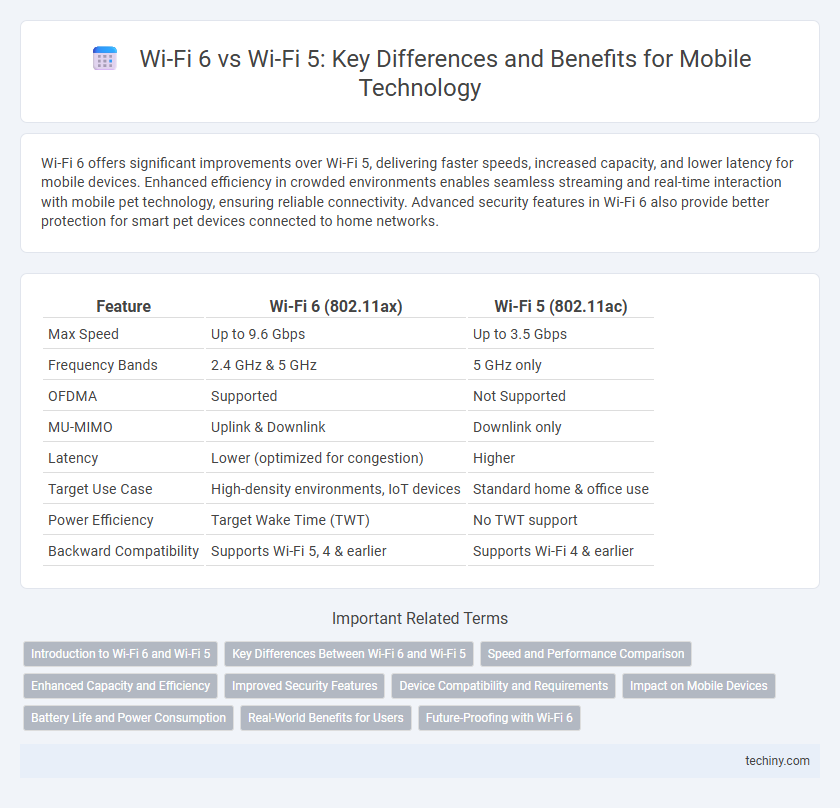Wi-Fi 6 offers significant improvements over Wi-Fi 5, delivering faster speeds, increased capacity, and lower latency for mobile devices. Enhanced efficiency in crowded environments enables seamless streaming and real-time interaction with mobile pet technology, ensuring reliable connectivity. Advanced security features in Wi-Fi 6 also provide better protection for smart pet devices connected to home networks.
Table of Comparison
| Feature | Wi-Fi 6 (802.11ax) | Wi-Fi 5 (802.11ac) |
|---|---|---|
| Max Speed | Up to 9.6 Gbps | Up to 3.5 Gbps |
| Frequency Bands | 2.4 GHz & 5 GHz | 5 GHz only |
| OFDMA | Supported | Not Supported |
| MU-MIMO | Uplink & Downlink | Downlink only |
| Latency | Lower (optimized for congestion) | Higher |
| Target Use Case | High-density environments, IoT devices | Standard home & office use |
| Power Efficiency | Target Wake Time (TWT) | No TWT support |
| Backward Compatibility | Supports Wi-Fi 5, 4 & earlier | Supports Wi-Fi 4 & earlier |
Introduction to Wi-Fi 6 and Wi-Fi 5
Wi-Fi 6, also known as 802.11ax, introduces significant advancements over Wi-Fi 5 (802.11ac) by offering higher data rates, increased capacity, and improved performance in dense environments. Wi-Fi 6 utilizes technologies like Orthogonal Frequency-Division Multiple Access (OFDMA) and Target Wake Time (TWT) to enhance network efficiency and reduce latency. Compared to Wi-Fi 5, Wi-Fi 6 provides better power management for mobile devices and supports more simultaneous connections, making it ideal for modern smart homes and crowded public spaces.
Key Differences Between Wi-Fi 6 and Wi-Fi 5
Wi-Fi 6 offers significant improvements over Wi-Fi 5, including higher data transfer speeds up to 9.6 Gbps compared to 3.5 Gbps, enhanced network efficiency through Orthogonal Frequency Division Multiple Access (OFDMA), and better performance in congested environments. The new standard supports Target Wake Time (TWT) for improved battery life on mobile devices and increased capacity with up to four times more simultaneous device connections. These advancements make Wi-Fi 6 ideal for smart homes, IoT applications, and high-density public spaces requiring reliable, fast connectivity.
Speed and Performance Comparison
Wi-Fi 6 offers significantly higher speeds than Wi-Fi 5, with theoretical maximum data rates reaching up to 9.6 Gbps compared to Wi-Fi 5's 3.5 Gbps, enhancing overall network throughput. Improved performance under congested environments is enabled by Wi-Fi 6's technologies such as OFDMA and MU-MIMO, allowing more efficient data distribution among multiple devices. Lower latency and better power efficiency in Wi-Fi 6 devices result in a smoother, faster mobile connectivity experience, especially in dense urban settings.
Enhanced Capacity and Efficiency
Wi-Fi 6 offers significantly enhanced capacity compared to Wi-Fi 5 by utilizing Orthogonal Frequency Division Multiple Access (OFDMA) technology, enabling simultaneous data transmission to multiple devices. This improvement drastically increases network efficiency, reducing latency and congestion in high-density environments such as offices and public spaces. Advanced features like Target Wake Time (TWT) further optimize power consumption and device scheduling, leading to longer battery life and sustained performance in mobile technology.
Improved Security Features
Wi-Fi 6 introduces enhanced security protocols such as WPA3, offering stronger encryption and improved protection against cyber threats compared to Wi-Fi 5's WPA2. It supports individualized data encryption through Forward Secrecy, which safeguards user credentials even if a key is compromised. These advancements bolster device authentication and ensure safer connections in densely populated wireless environments.
Device Compatibility and Requirements
Wi-Fi 6 supports a broader range of devices with enhanced compatibility, including smartphones, laptops, and IoT gadgets featuring the latest chipsets, while Wi-Fi 5 primarily serves older devices with less demanding bandwidth needs. Devices optimized for Wi-Fi 6 require compatible routers and network adapters that support OFDMA and MU-MIMO technologies for improved performance and low latency. Upgrading to Wi-Fi 6-enabled equipment ensures backward compatibility with Wi-Fi 5, but older devices will not benefit from Wi-Fi 6's advanced features and higher efficiency.
Impact on Mobile Devices
Wi-Fi 6 enhances mobile device performance by providing faster data transfer speeds up to 9.6 Gbps compared to Wi-Fi 5's 3.5 Gbps, significantly reducing latency and improving streaming quality. Its improved Multi-User Multiple Input Multiple Output (MU-MIMO) and Orthogonal Frequency Division Multiple Access (OFDMA) technologies optimize network efficiency for concurrent device connections. Increased battery efficiency in mobile devices results from Wi-Fi 6's Target Wake Time (TWT) feature, extending device usage in congested network environments.
Battery Life and Power Consumption
Wi-Fi 6 significantly improves battery life and reduces power consumption compared to Wi-Fi 5 by utilizing Target Wake Time (TWT) technology, which schedules data transmission to minimize device activity. This efficient power management allows mobile devices to conserve energy during idle periods, extending overall battery longevity. Enhanced modulation and wider bandwidths in Wi-Fi 6 further optimize wireless communication efficiency, making it ideal for modern mobile technology needs.
Real-World Benefits for Users
Wi-Fi 6 delivers faster speeds, higher capacity, and improved performance in crowded environments compared to Wi-Fi 5, enhancing user experiences in homes, offices, and public spaces. Enhanced features like Orthogonal Frequency Division Multiple Access (OFDMA) and Target Wake Time (TWT) reduce latency and extend battery life for connected devices. These real-world benefits translate into smoother streaming, quicker downloads, and more reliable connections for smartphones, laptops, and IoT gadgets.
Future-Proofing with Wi-Fi 6
Wi-Fi 6 offers enhanced future-proofing through higher data rates up to 9.6 Gbps and improved network efficiency using OFDMA and MU-MIMO technologies, supporting the increasing number of IoT devices and smart applications. Its improved latency and capacity make it ideal for densely populated environments, ensuring seamless connectivity as mobile technology advances. Investing in Wi-Fi 6 guarantees compatibility with upcoming devices and the evolving demands of mobile communications.
Wi-Fi 6 vs Wi-Fi 5 Infographic

 techiny.com
techiny.com